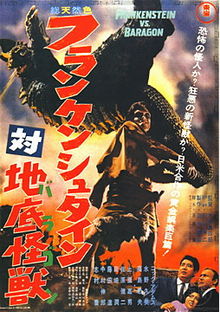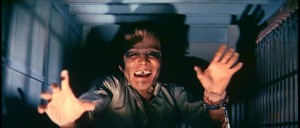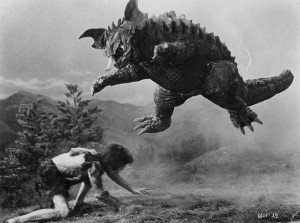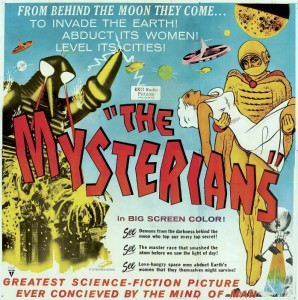Continuing my series of mini-reviews of recently viewed giant monster B-movies, this time I’ll serve up another pair of Toho Studios’ lesser-known kaiju and science fiction pictures: Frankenstein vs. Baragon/Frankenstein Conquers the World (1965) and The Mysterians (1957).
Netflix made a boo-boo when they sent me Frankenstein Conquers the World; they shipped the disk containing the Japanese language version with English subtitles. Judah, my youngest, had been very anxious to see this film, what with it containing the first appearance of Baragon, one of his favorite Japanese monsters (he has a Baragon stuffed toy that he loves). I was afraid he would refuse to watch it if it had subtitles, since he had told me, very firmly, that he would NOT watch our VHS copy of Godzilla vs. Hedorah/Godzilla vs. the Smog Monster, due to it being in Japanese with English subtitles. However, the little guy surprised me by acquiescing to Frankenstein Conquers the World with subtitles. My oldest boy, Levi, said he wanted to split the task of reading the subtitles aloud with me. A family activity!
As things turned out, I doubt we would have enjoyed the movie any more had it been dubbed; it’s possible our viewing experience was even enhanced by watching it in its original Japanese. In any case, much of the dialogue was inessential; the pictures told the story. And, oh, what a story!
I’m pretty sure kaiju Frankenstein has the most convoluted origin story of any of the Japanese monsters (with the possible exception of King Ghidorah in the second series of Godzilla movies). The film begins in Germany during the final months of World War Two, inside the laboratory of Dr. Frankenstein (or some other scientist who has taken over Dr. Frankenstein’s work… hard for me to tell with all the confusion surrounding the speed-reading of subtitles to my kids). Nazi soldiers show up to confiscate what is apparently the last remaining piece of the Frankenstein monster — his still-beating heart, floating in a glass jar. They store this in a crate and ship it out to Japan aboard a U-boat, apparently so that Imperial Japan can continue Nazi Germany’s quest for an invincible super-soldier (the thought being that the monster’s indestructible heart might provide a serum or compound which would allow soldiers to regrow body parts lost in battle). The U-boat rendezvouses with a Japanese Navy submarine in the Sea of Japan, and the Germans transfer their strange cargo. But before the two subs can submerge, an American sub-hunting sea plane attacks and sinks the U-boat. The Japanese sub escapes and delivers the monster heart to a research institute located in the center of Hiroshima. Yes, that Hiroshima. The research institute is near ground zero of the atomic bomb explosion. We are then led to believe that the heart survived the explosion and absorbed enough radiation to cause it to grow into an entire person — a new, childlike Frankenstein’s monster, whom postwar residents of Hiroshima assume to be a war orphan.
(I’ve read that an early version of the movie, possibly released to theaters in Japan, actually had a war orphan eat the heart and then mutate into a Frankenstein’s monster-like creature. But in this version, scientists explain that the heart itself grew into the creature.)
One of the most amusing aspects of the movie is the multiple instances in which Japanese scientists or reporters insist that one of the curious anomalies about the weird, growing child is that “he is clearly of Caucasian ancestry” (this being necessary because the original Frankenstein’s monster was put together from pieces of dead Central Europeans). However, take a look at that punim — he is clearly NOT of “Caucasian ancestry!” So, the movie scientists seem to be saying, who’re you going to believe – me or your lying eyes?
Also rather amusing was watching and listening to American actor Nick Adams (who also stars in Monster Zero) dubbed into Japanese. The Japanese voice actor’s bass pitch is much lower than Adams’ natural, rather high-pitched voice, so he almost seems to be talking in slow-motion.
But the really fun parts of the movie are the monster fights between Frankenstein and Baragon. Since the actor portraying Frankenstein is unencumbered by a massive rubber suit, he is able to move and fight much more fluidly than your typical kaiju. Just to ensure that Baragon would not seem overmatched, the producers gave the subterranean dinosaur the ability to leap great distances. So the extended fight scenes are very involving, more like the fights in Hong Kong kung-fu flicks than the typical lumbering shoving matches featured in kaiju movies. Also, the Frankenstein creature is portrayed in a sympathetic light and has more of a relatable personality than a typical kaiju. A semi-sequel was made the following year in 1966 — The War of the Gargantuas. I say “semi-sequel” because, although elements of the earlier movie’s story are clearly referenced in Gargantuas, and the Brown Gargantua’s personality and motivations carry over from those of the Frankenstein creature, the two monster’s designs are very different; Brown Gargantua looks much more like a Bigfoot monster than a Frankenstein’s monster.
Apparently this DVD edition of Frankenstein Conquers the World was released in conjunction with fresh home editions of The Mysterians, Mantango/Attack of the Mushroom People, Dagora, the Space Monster and Atragon (the Frankenstein disk includes promos/theatrical trailers for each of these Toho films). Judah told me he wanted to see all of them. Unfortunately, the copy of The Mysterians I had available to show him was an old VHS copy I had picked up used at a science fiction convention. Picture quality was pretty sub-standard, even for VHS; and given that the colorful, extravagant production design of The Mysterians is its major calling card, that was a bit of a shame. (I may have to hunt up a DVD of this film and see if improved picture quality makes me think more highly of it.)
The film’s story (to be echoed in many later Toho films that featured aliens and kaiju) cannot be accused of being overly ambitious or creative – an alien race from a dying world wants to take over Earth; they initially pretend to be Earth people’s benefactors, or at least not overtly hostile; when their falsehoods need to be abandoned, they then use what seems to be superior technology to overcome Earth’s defenses. However, the plot and screenplay are full of holes big enough to pilot a spacecraft through. We are led to believe that the alien incursion is of fairly recent vintage; they have been secretly building an underground fortress in Japan, but they haven’t quite finished it when the film begins, and the film’s climax features a race between the aliens completing their fortress and making it impregnable and the United Nations of Earth developing and fielding their own super-weapons. However… the aliens’ initial attack on Japan comes courtesy of a gigantic robot (called Mogera) which emerges from inside a mountain. Japan is one of the most densely populated nations on Earth – how did the aliens manage to dig out the inside of a mountain and place a fricking hundred-foot-tall robot inside it without anyone noticing? For that matter, where have they been getting all their building supplies to create their giant underground fortress? From a Japanese branch of Home Depot? If they brought the supplies in from their home planet, the landings of that many tremendous cargo rockets would’ve attracted a bit of attention, too, no? The United Nations manages to field two huge rocket battlecraft to engage the Mysterians’ fortress. The Mysterians blow up one of the battlecraft with a ray blast, but fifteen minutes later in the film, the same ray blast strikes the second, seemingly identical U.N. battlecraft with no effect whatsoever.
The Mysterians (1957) can be thought of as a Japanese reply to This Island Earth (1955), Earth vs. the Flying Saucers, and Forbidden Planet (1956), three hit American science fiction films from the two prior years. What it lacks in script sophistication (a highlight of Forbidden Planet, which, after all, was loosely based on Shakespeare’s The Tempest), it makes up for with the sheer exuberance of its production design – costumes, miniatures, and sets. The aliens’ costumes are delightful, a cross between the couture of Pop Art bikers and gay vampires (right after the film, Judah immediately assembled his own version of a Mysterian uniform, which he wore continuously for the next three days). The giant robot Mogera is very memorable — sort of the Michelin Tire Man with the head of a tin anteater. Best of all are the ships and weaponry, all pieces from a ten-year-old’s fantasy space war play set. Toho’s artisans fashioned miniatures which would serve them well in many kaiju epics to come, particularly the mobile electro-ray projectors mounted on military flatbed trucks. And those hovering U.N. battle rockets look mighty cool, too.
The American film that The Mysterians most closely models is Ray Harryhausen’s stop-motion alien extravaganza, Earth vs. the Flying Saucers. It’s a little dumber, perhaps, than Harryhausen’s picture (which, for once, did not have the American military acting like a bunch of bellicose idiots), but it has the advantage of being far more colorful — Toho’s first movie to be filmed in beautiful Tohovision! That, and those funky alien uniforms (so much more fabulous than the aliens’ suits of armor in Earth vs. the Flying Saucers), certainly counts for something, I think…









The Mysterians used to be a staple of free broadcast tv movies, and as a kid, I always thought it was Toho’s best attempt at a “serious” sf film. The Tokyo Shock DVD is excellent and amazingly inexpensive for such as good widescreen transfer. I also loved, as a ten or eleven year old, Atragon. Try that one with your sons. I bet they’ll like it.
Dear Peter,
Thanks so much for the recommendations! My copy of The Mysterians is a very old and worn VHS copy, so I’ll definitely look for the Tokyo Shock DVD version, based on your recommendation. And yes, I have shared Atragon with my boys. I agree that it is a wonderful fantasy movie. Please continue visiting the blog!